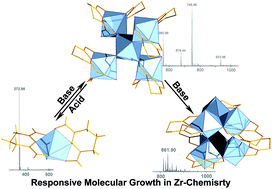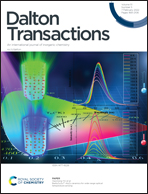Acid/base responsive assembly/dis-assembly of a family of zirconium(iv) clusters with a cyclic imide-dioxime ligand†
Abstract
The hydrolytically stable dioxime ligand (2Z-6Z)-piperidine-2,6-dione (H3pidiox) acts as a strong chelator mainly with hard metals in high oxidation states, a pre-requisite for potential applications in metal sequestering processes from aqueous solutions. Reaction of ZrCl4 with H3pidiox in methanol gives the mononuclear compound [ZrIV(η1,η1,η2-H2pidiox-O,N,O′)2(OH2)2]Cl2·H2O·CH3OH (1), while the same reaction mixture in the presence of KOH gave the pentanuclear ZrOC [ZrIV5(μ2-OH)4(OH2)4(μ2–η1,η1,η2-Hpidiox-O,N,O′)4(η1,η1,η1-HpidioxO,N,O′)4]·5KCl·3CH3OH·8H2O (2). Compound 1 is formed at very acidic pH = 0, and the pentanuclear ZrOC 2 at higher pH values (pH = 2). Compounds 1 and 2 were characterized by single crystal X-ray structure analysis, multi-nuclear NMR spectroscopy and ESI-MS spectrometry. The single crystal X-ray structure analysis of 1 revealed a mononuclear zirconium(IV) compound containing an eight-coordinate zirconium atom bound to two singly deprotonated H2pidiox− ligands and two water molecules in a severely distorted bicapped octahedral geometry. The pentanuclear ZrOC 2 constitutes the second example of a Zr5 cluster to be reported and the first one in which the four zirconium atoms are arranged in a tetrahedral arrangement with the fifth occupying the center of the tetrahedron. 1D and 2D NMR spectroscopies of the acidic CD3OD solutions of complex 1 reveal a fast equilibrium between 1 and 2. Addition of KOH into a CH3OH solution of 2 results in the controlled fast transformation of 2 to an asymmetric hexanuclear ZrOC 3 as evidenced by the NMR and real-time ESI-MS solution studies. Further addition of KOH to the solution of 3 leads to the ZrOC 4, and on the basis of NMR and ESI-MS data and in comparison with the known hexanuclear titanium(IV)/H3pidiox cluster, it is concluded that the cluster 4 should have a hexanuclear structure. Electrospray ionization mass spectrometry (ESI-MS) demonstrated not only the structural stability 1 and 2 in solution, but also revealed the reversible pH driven dis-assembly/re-assembly process between the monomeric 1 and the pentanuclear ZrOC 2.



 Please wait while we load your content...
Please wait while we load your content...